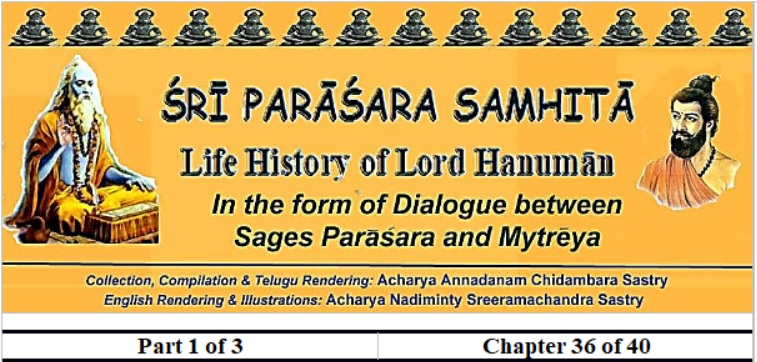
36th Chapter (Şaţrinśatpaţalah)
“The Story of the Mantra for Stalling the Rousing of the Desire”
(Madanakşōbhā Nivāraka Mantra Kathanam)
श्रीपराशर:
श्लोक:
मन्त्रांतरं प्रवक्ष्यामि मैत्रेय त्रूणु मारुते
मनोब्र्ह्मा ऋषिश्चैव गायत्री छन्द उच्यते।। 1
Seer Parāśara:
The Desire-Stalling Mantra
“Oh! Sage Mytrēya! I am telling about another mantra of Hanumān. Listen. Brahma himself is its sage (Ŗşi). Gāyatrī is said to be the metre (chandas). (1)
हनुमान् देवता ह्रां च बीजं ह्रीं शक्तिरुच्यते
क्रीं कीलकं महाभागो विनियोगपदं भवेत्।। 2
After saying ‘Hrām’ as the seed (beeja), ‘hrīm’ as the power (śakti) and ‘krōm’ as the key (keelakam); Oh! Great sage! Then the usage (viniyōgah) has to be told. (2)
ह्रामित्यस्त्यगुलिन्यास: ह्रदयादिस्तथैव च
कुर्याद्दिग्बन्धनं तत्र लोकभयेन बुद्धिमान्।। 3
Starting from ‘hrām’, the finger-gesturing (anguļinyāsa) has to be performed. Similarly heart touching-posturing (hŗdayādinyāsa). Then the reciter has to construct protective (imaginary) ring aaround saying ‘lōkatrayēņa digbandhah’. (3)
ध्यानम्
आव्म्जनेयमतिपाटलाननम्
काव्म्चनाद्रिकमनीयविग्रहम्
पारिजाततरुमलू वासिनं
भावयामि पवमाननन्दनं।। 4
Dhyāna (Meditation): I meditate on the son of Wind God that has a very reddish face, lives at the base of the Parijāta – celestial tree. (Āńjanēya matipātalānanam – kańcanādri kamanīya vigraham| Pārijātatarumūla vāsinam – bhāvayāmi pavamānanandanam||) (4)
आदौ प्रणवमुच्चार्य नमो भगवते पदं
अनन्तरं हनुमते मम शब्दस्तत: परम्।। 5
First saying the cosmic sound ‘Ōmm’, say ‘namō bhagavatē’ and then ‘mama’, (5)
मदनक्षोभमुच्चार्य संहरेति द्विरुच्चरेत्
आत्मतत्त्वं ततश्चैव प्रकाशय द्विरुच्यते।। 6
(Then) say ‘madanakşōbham’, then ‘samhara samhara’ (i.e., twice), then ‘ātmatattvam’, then say ‘prakāśaya prakāśaya’ (i.e., twice). (6)
वाराहबीजमुच्चार्य फट् स्वाहा तत: परम्
एक चत्वारिंशद्वर्ण मन्त्रो विद्याप्रदोहय:।। 7
Then utter ‘humm’, the varāhabeejamantra (root mantra of the Boar, (3rd, incarnation of Vişņu), and then ‘phat swāhā’. This is the 44-lettered great mantra (count does not match, however). This mantra is educative. (Ōmm! Namō bhagavatē! Mama madanakşōbham samhara samhara! Ātmatattvam prakāśaya prakāśaya! Humm! Phat swāhā’ = Ōmm. Reverential bow to the Almighty! Destroy! Destroy my Cupid Manmatha roused desire! Brighten ! Brighten! My inner nature! Humm! Phat! Burn it), (7)
पुनर्मंत्रांतरं वक्ष्ये पिशाचादिनिवृत्तये
कस्मिन् कुक्षौ वरवर अव्म्जनावरपुत्र च
आवेशावेशय पदं ओं ह्रीं हनुमतस्तथा।। 8
Mantras for Control over Spirits & Hanuman’s Benevolence
Oh! Great sage Mytrēya! I am telling you another mantra for controlling wandering spirits (piśācas). In the same manner as reciting the above mantra, say ‘Ōmm hrīm Hanumatē’, then saying ‘vara vara Ańjanāavaraputra’, then ‘āvēśaya āvēśaya’ (= Favoured son of mother Ańjana! Favour! Favour! Deliver! Deliver! Free me), (8)
फट्स्वाहेति मन्त्रो यं त्रिंशद्वर्णसमन्वित:
ऋष्यादिध्यानन्यासादीन् पूर्वमन्त्रवदीरित:।। 9
Then say ‘phat swāhā’. This is told to be the 30-lettered mantra. The sage and others, dhyāna-nyāsa and others to be followed for it are like for the previous mantra. (9)
मंत्रांतरं पुनर्वक्ष्ये मुने! लोकोपकारकम्
वशिष्ठऋषिरस्यैव अनुष्टुप् छन्द उच्यते।। 10
Oh! Great Sage Mytrēya! For the benefit of the world, I am telling again another mantra. The sage (ŗşi) for it is said ro be Vasişţha and the metre (chandas) as anuşţup. (10)
हनूमान्देवता प्रोक्तो ह्रीं बीजं तदनन्तरम्
क्लीं शक्ति: कीलकं क्रीं च ममेति च पदं तथा।। 11
Hanumān is told as the Lord. Then ‘hrīm’ as the seed (beejam), ‘klīm’ as the power (śakti) and ‘krōm’ as the key (keelakam) are told, and then putting the word ‘mama’ (11)
हनुमत्प्रसादसिद्ध्यर्थे विनियोगस्तथोच्चरेत्
ओं नमो भगवते च अंगुष्ठाभ्यां विन्यसेत्।। 12
Then to be said, ‘Hanumatprasāda siddhyardhē viniyōgah’. Then saying ‘Ōmm anguşţţhābhyām namah’, perform the gesticulations of the thumbs. (12)
मम मदनक्षोभं तर्जनी।
सहर संहर चेति मध्यमा।
आत्मतत्त्वपदं चेत्यनामिका।
प्रकाशय पदद्वन्द्वं कनिष्ठिका।। 13
Mama madanakşōbham tarjanibhyām namah’ ‘samhara samhara’ (Bow to the index fingers! Destroy Destroy! My Cupid Manmadha roused desire!), ‘Madhyamābhyām namah’ (Bow to the mjddle fingers!) ‘ātmatattvam’ (inner nature / consciousness), ‘anāmikābhyām namh’ (Bow to the ring fingers!), ‘prakāśaya prakāśaya‘ (Brighten! Brighten!), ‘kanişţikābhyām namah’ (Bow to the little fingers!), ‘Ōmm phat swāhā karatala karapŗşţhabhyam namh’ (Bow to the inner and outer surfaces of the palms! Offering to the fire sacrifice) – so performed is the hand gesticulations (karanyāsa). Similarly perform body touching gestures (ańganyāsa). (13)
(औंफट् स्वाहेति तथा करतले विन्यसेत् एवं ह्र्दयादिन्यास:)
ध्यानम्
वामे जानुनि वामहस्तमपरं ज्ञानाख्यमुद्रान्वितम्
ह्र्द्देशे कलयन्नुतो मुनिगणैरध्यात्मदक्षेक्षणै:।।
आशीन: कदलीवने मणिमये बालार्ककोटिप्रभ:
ध्यायन् ब्रह्मपरं करोतु मनसश्शुद्धिं हनूमन्मम।। 14
May Lord Hanumān, keeping His left palm on his left thigh, keeping His right palm in gńyāna mudra (knowledge gesture) on his heart region, being praised by the sasges, having looks full of spiritual discipline (ādhyātma tattva nişţha), sitting on a flat diamond boulder in the banana grove, having brightness higher than that of the rising Sun and deeply meditating on the Supreme Being – give purity and serenity to my soul. (14)
आदौ प्रणवमुच्चार्य ततो हनुमते पदं
ममेति पद मुच्चार्य मदनक्षोभ मेवच।। 15
First utter the cosmic sound ‘Ōmm’, then the word ‘Hanumatē’. Then the word ‘mama’, then say ‘madanakşōbham’, (15)
संहरेति द्विरुच्चार्य वाराहबीजमुच्चरेत्
फट् स्वाहेति मन्त्रो यं सप्तत्रिंशतिवर्णक:।। 16
(Then) saying twice ‘samhara samhara’, followed by the Varāha beeja (seed) and then say ‘phat swaha’. This is the 37-lettered mantra. It is known from the earlier scholars that the previously mentioned words ‘namah’, ‘ātmatattvam’, ‘prakāśa’ and others are also accepted in this mantra, so that the number of lettres are complete. (16)
शीर्षालीकश्रवणनेत्रकपोलनासा
पादसन्धिकटिनाभिपाश्र्वह्रत्सुकर-
स्तनयुग्ममुखमूर्ध्नि च क्रमेण
मन्त्राक्षरान् न्यसेत् शुद्धमति: स्वदेहे। 17
Head, forehead, eyes, cheeks, nose, feet, inguinal region (between thighs), hip, navel, sides, hwart region, hands, breasts, face and head of the body of the mantra reciter have to be touched in that order by him/her while reciting the manmtra letters; this is nyāsa. (17)
कदलीफलै: पनसफलैश्च मधुमिश्रितै:
हनूमद्देवताप्रीत्यै होमं कुर्याद्विचक्षण:।। 18
A knowledgeable reciter performs hōma (fire sacrifice) with banana and jackfruit mixed with honey, for pleasing Lord Hanumān. (18)
लक्षमेकं पुरश्चर्या दशांशं तर्पणं भवेत्
दशांशं हवनं कुर्यात् दशांशं भोजनं तत:।। 19
Worshipping Hanumān Yantra (Amulet)
This mantra recitation cycles (puraścarya) have to be repeated 100,000 times. Out of this 1/10th has to be water offerings (jala tarpaņa), 1/10th fire sacrifice and another 1/10th – offering of cooked rice (annasamārādhana). (19)
अथ पूजाविधानार्थं यन्त्रलक्षणमुच्यते
नवशक्तियुते पीठे शैवे थ वैष्णवे तथा।। 20
For further methodology of worship, features of an amulet (yantra) are described. A nine-powered Almighty’s divine seat (navaśakti sahita daivaipeetha) or a Vişņupeetha, (20)
सामान्यपीठे चावाह्म पूजयेत्समुदाह्मतं।। 21
Or on any other ordinary seat, the anulet has to be invited (āvāhana) and established (sthāpana). (21)
आदौ वर्तुलमालिख्य भूपुरद्वयलेखनम्।। 22
Drawing a small circle first, draw a 8-petalled lotus (aşhţadaļapadma). Then draw a circle and two rectangles. (See Chapter 7). (22)
चतुद्र्वारं समालिख्य चक्रलक्षणमुच्यते
कर्णिकायां लिखेत्तारं साध्यगर्भं च तद्बहि:।। 23
Then arrange (in the drawing) four gates. So described is the feature of that amule (yantra or cakra = disc). After writing Ōmm (ॐ) in the central circle (imagining it to bw the pericarp of a lotus), the sacred letters of the mantra have to be written, one after the other, in the 8 petals of the lotus (23)
अष्टपत्रे केसरोद्यत्स्वरद्वन्द्वे मनो: क्रमात् 24
Seven letters in the first petal, four letters in the second petal, seven letters in the third petal and three letters each in the fourth and fifth petals have to be written. (24)
आद्ये सप्त द्वितीये च चतुरार्णो तृतीयके
सप्त तुर्ये पव्म्चमे च त्रीणि त्रीण्यक्षराण्यपि।। 25
Four letters each have to be written in the sixth, seventh and eighth petals. (25)
षट्सप्ताष्टमपत्रेषु चतुरश्चतुरक्षरान् ।। 26
In then remaining spaces of the circle, within the rectangles and rectangular areas the cosmic sound ‘Ōmm + Sree’ has to be written. (26)
वृत्तोल्लसत्कादिवर्णं भूपुरश्रीस्थतारकं
चतुरावरणांश्चैव चक्रस्यास्य विलेखयेत्।। 27
Then life-impartation (prāņapratişţa) has to be performed (as per given procedure). There will definitely be a success of the efforts (kāryasiddhi). This Hanumān amulet (yantra) is capable of fulfilling the desires. (27)
प्राणप्रतिष्ठां कुर्वीत कार्यसिद्धिर्भवेद्धु्रवम्
हनूमतो यन्त्रमेतद्वाव्म्छितार्थप्रदं परम्।। 28
The desire aroused by Cupid Manmadha will abate and soul will attain great peace and purity in whoever writes this great manthra on butter and recites it and then eats it (butter). (28)
इदमेव विलिख्य साधु यन्त्रं
नवनीते प्रतिजप्य मंत्रमेनं
परिभक्षयतामनड्गपीडा
प्रशमं गच्छति शुद्धमेति चेत:।। 29
आदाय दोष्णा सलिलं प्रसन्नं
प्रजप्य मंत्रं प्रपिबेत्त्त्रिवारं
रागादिदोषप्रतिमाय बुद्धे
ज्र्ञानोदयाय प्रशमाय वृत्ते:।। 30
If pure water is taken in the joined palms, mantra recited and the water drank thrice, desires and dislikes will all go and one will attain knowledge (gńyānōdaya); and all difficulties in daily living would go away, giving away to peace of mind. (29-30)
इति श्रीपराशरसंहितायां श्रीपराशरमैत्रेयसंवादे मदनक्षोभनिवारकमन्त्रकथनं नाम षट्त्रिंशत्पटल:
Thus ends the 36th Chapter (Şatrinśatpaţalah) “The Story of the Mantra for Stalling the Rousing of the Desire” (Madanakşōbhā nivāraka mantra kathanam) of Śrī Parāśara Samhitā
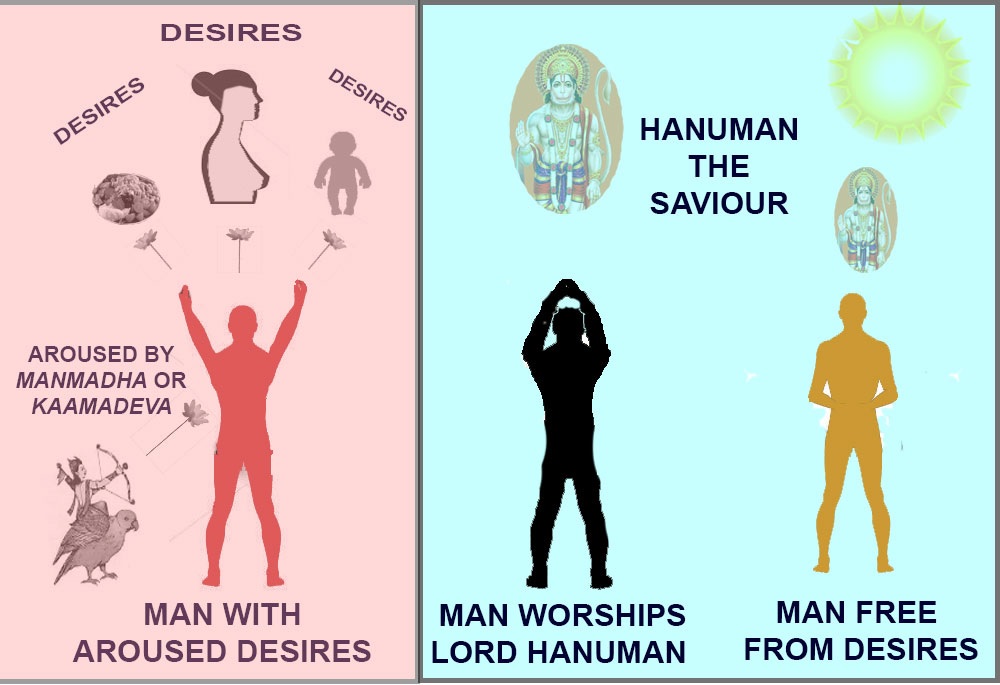
![]()

Click here to visit the Contents of the Part 1.
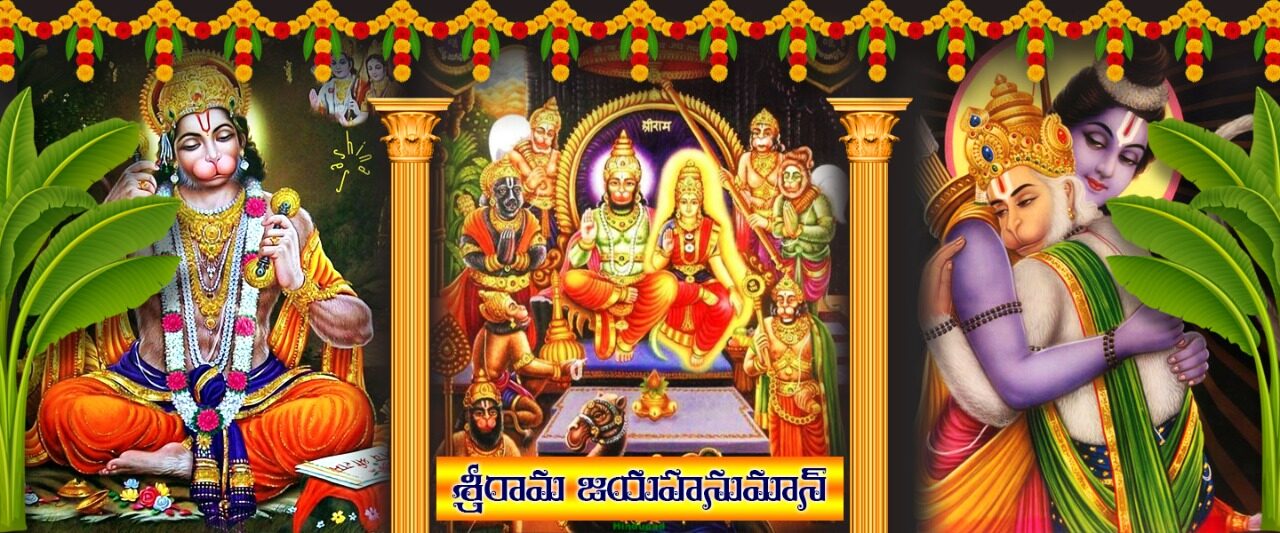
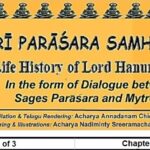

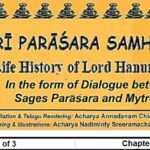
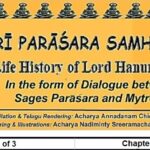

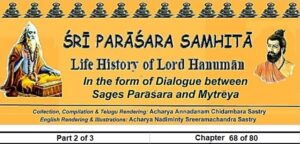
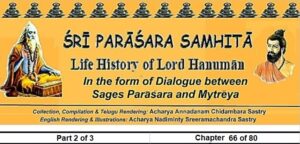
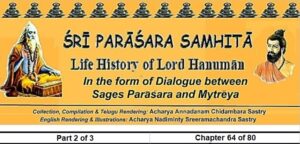
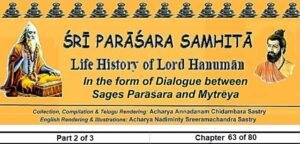
Be First to Comment